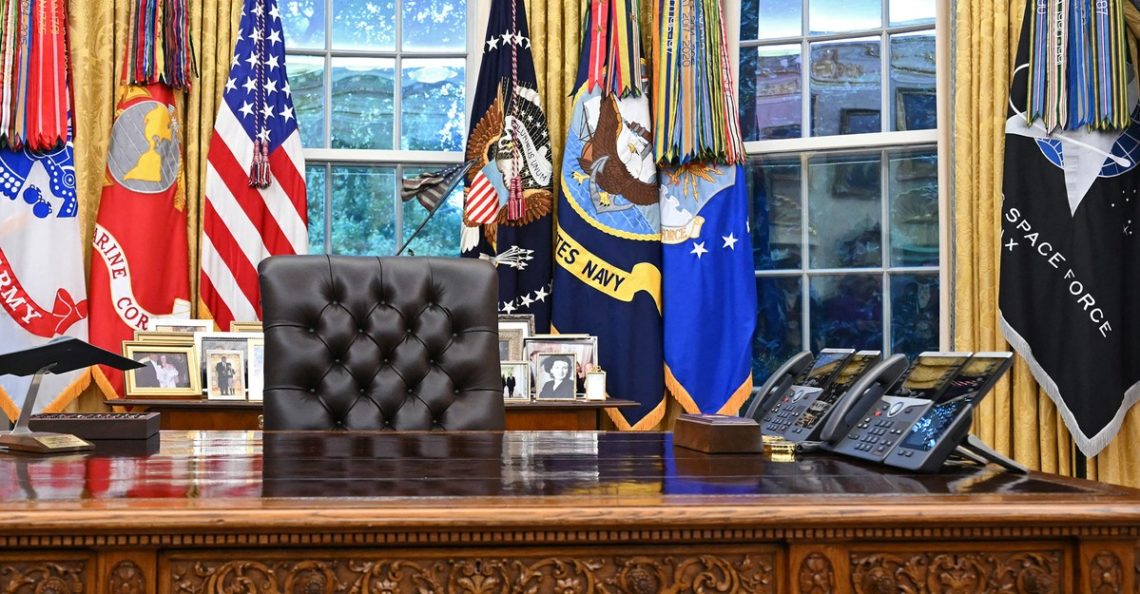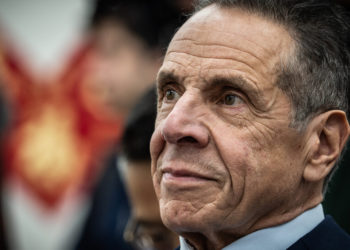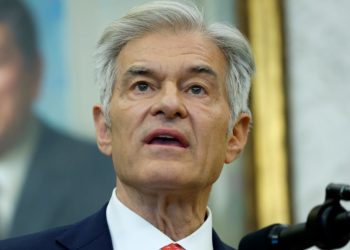In the 29 days that the government has been closed, President Donald Trump has not traveled to Capitol Hill to jump-start negotiations, brought congressional leaders to the White House to broker a deal, or given a speech to the American public about the crisis.
He’s done a lot else in October: traveled out of the country twice; defended the demolition of the East Wing to make room for a giant ballroom; asked for (and, in several cases, received) prosecutions of his political enemies and granted clemency to allies; demanded a $230 million payment to himself from the Justice Department; and authorized numerous strikes on alleged drug boats. Trump has also posted AI-generated videos of himself dressed like a king, using a fighter jet to drop excrement on protesters, or, parodying Blue Öyster Cult’s “(Don’t Fear) The Reaper,” playing cowbell as his budget director (dressed as the Grim Reaper) seeks to traumatize the federal workforce.
But when it comes to the government shutdown, Trump barely seems to be paying attention. Some of this aloofness is by design, the president’s aides told us, describing a monthlong strategy of putting the onus for reopening the government on Democrats. It’s a departure from how Trump handled a shutdown during his first term, when, over the course of 35 days, he employed tactics that are a lot more standard for a president: huddling with lawmakers, empathizing with furloughed workers, and addressing the American public. As the country approaches November 1, when money for food-assistance benefits will run out and many Americans will receive notices stating that their health-care premiums for next year will skyrocket, some Republicans have begun to push back against Trump’s absentee approach. They’re signaling publicly and in private that they want him to employ an The Art of the Deal-type strategy and help end the shutdown.
Trump is “the leader of the band,” Senator Jim Justice of West Virginia told reporters recently. “So at some point in time, the leader of the band is going to step up and guide us.” Senator Rand Paul of Kentucky also urged Trump to engage. “I suggest President Trump come forward and name three Republicans and three Democrats in the Senate to an official commission to figure this out,” he said on Fox News Sunday.
Some of Trump’s closest advisers told us that the president has been distracted and busy dealing with other matters. The past four weeks have been among Trump’s most active on foreign policy: The president has brokered a cease-fire between Israel and Hamas, inched the United States to the brink of war with Venezuela, financially supported Argentina, advanced a trade deal with China, slapped additional tariffs on Canada, and attempted diplomacy between Russia and Ukraine. On Sunday, Trump told reporters traveling with him in Asia that he would be open to extending his five-day trip in order to meet with the North Korean dictator Kim Jong Un. As Trump has spent his time shaping—or, as is often the case, generating—headlines on these and other issues, the shutdown has receded from the front page, even as large swaths of the bureaucracy remain closed and hundreds of thousands of employees go without pay.
For much of the past month, Republicans felt that they were winning the shutdown debate and that the Democrats they blamed for the impasse would likely splinter. But Democrats have surprised them by remaining largely united on their demands to extend expiring health-care subsidies in exchange for reopening the government, even as the Republican strategy of keeping the House out of commission for weeks and repeatedly holding failed votes in the Senate has started to wear thin with some members.
A group of 13 House Republicans wrote a letter last week to Speaker Mike Johnson, saying that Congress should “immediately turn our focus to the growing crisis of healthcare affordability” once the government reopens. Several Republicans have also called for the House, which has not held a vote since September 19, to return to work.
As the impact of the shutdown threatens to spread deeper into the country, Trump could soon confront the reality that when a crisis hits, the public often turns to the president for leadership—or for blame. It would not be a new concept for Trump, who repeatedly singled out then-President Barack Obama during congressional stalemates over funding. “If there is a shutdown, I think it would be a tremendously negative mark on the president of the United States,” Trump said on NBC’s Today in 2011. “He’s the one that has to get people together.”
By 2018, Trump was still publicly opining on the president’s ability to make shutdown deals, but this time, he was weighing in from the West Wing. “I am all alone (poor me) in the White House waiting for the Democrats to come back and make a deal,” he tweeted on Christmas Eve. As the shutdown continued into the new year, Trump invited Democratic leaders to the White House; canceled a planned trip to the World Economic Forum in Davos, Switzerland; and gave a prime-time speech to assure Americans that his administration was “doing everything in our power to help those impacted by the situation.” Even mundane events at the White House became opportunities for Trump to drive his shutdown messaging. When football players from Clemson University visited the White House to celebrate their 2018 national championship, Trump ordered McDonald’s. The White House said that Trump paid for the spread himself, because furloughed staff were not available to serve more upscale fare.
Such constraints have not been a factor during the current shutdown. On October 15, dozens of millionaires and billionaires gathered at the White House to sip wine and hear Trump’s vision for a grand ballroom. (Most of the attendees, among them executives from Amazon, Apple, Microsoft, and other companies, were also paying for it.) They were served heirloom-tomato panzanella salad and beef Wellington on gold-trimmed plates, according to the Associated Press. By the president’s own admission, the 90,000-square-foot ballroom has taken up a large share of his focus lately. He’s been having multiple meetings a week about it, and as a demolition crew was reducing the East Wing to rubble, he pointed to a model of the White House that included the ballroom and declared, “I’ve shown this to everybody that would listen.”
Trump sees the project as another way to leave a permanent mark on the White House, his allies told us. He enjoys living in the building—far more than some of his predecessors, who thought that it felt like a museum. For Trump, it’s the ultimate status symbol, but the real-estate mogul believes that even the most famous address in the world has gotten a little dated. He has told associates that he wants more of the comforts of Mar-a-Lago at 1600 Pennsylvania Avenue—and moving back in after reelection, he wasted little time paving over the Rose Garden for a patio, adding gold trim to the Oval Office, and planting large flag poles on the lawn. The president has told confidants that he loves the idea of seeing Donald J. Trump Ballroom—written in gold letters—etched somewhere in the White House. (The president recently told reporters that he would not be naming the ballroom after himself, and, if you believe that, we’ve got a fully intact East Wing to sell you.)
Some in the West Wing have delighted at what they perceive to be exaggerated outrage from critics over the destruction of the East Wing. But Trump, Democrats argue, cares more about a ballroom with a $350 million (and rising) price tag than about keeping prices and health-care costs down for average Americans.
Senator Bernie Sanders of Vermont highlighted the dichotomy last week, asserting that millions of Americans are on the verge of losing their health care amid a broader cost-of-living crisis.
“Meanwhile, Trump’s priorities are demolishing the White House, bailing out Argentina & now threatening war with Venezuela,” he wrote on X. “What happened to America First?”
This has become the go-to talking point for Democrats, who are openly seeking a political advantage amid their highest-profile battle in Trump’s second term. But Trump, who once boasted, “I alone can fix it,” has made himself vulnerable to such attacks by pushing the limits of his presidential powers and repeatedly steamrolling Congress. Democrats and Republicans have said that no legislation to reopen the government will pass without his blessing (Trump recently joked to allies, “I’m the speaker and the president,” The New York Times reported).
Senate Minority Leader Chuck Schumer of New York told reporters last week that he and House Minority Leader Hakeem Jeffries had contacted Trump to try to set up a meeting “anytime, any place.” Trump has shown no interest, instead asserting that he would be happy to meet with the Democrats after they vote to reopen the government.
Representative Don Bacon of Nebraska, a moderate Republican and an occasional Trump critic, told us that he thought it would be “helpful” for the president to get involved, especially because his signature will be needed on any bill that ends the impasse. Unlike GOP leaders, Bacon wants Republicans to start discussing a deal on health care even while the government remains closed. “I’m for negotiating now,” Bacon told us.
But he and other Republicans believe that Democrats might fold without a health-care agreement. This week, the largest union representing federal workers, the American Federation of Government Employees, called for an end to the shutdown. The union is a longtime Democratic ally, raising pressure on the party’s Senate caucus to relent. “Hopefully, we’re close to a cracking point,” Bacon said, citing the AFGE’s announcement.
Although Trump’s strategy has precedent—Obama in 2013 similarly took a stance of no negotiations while the U.S. government was held “hostage over ideological demands”—the president has not made his views clear on the issue at the core of the shutdown fight. Obama asserted that Republican demands that he repeal or delay his signature health-care law were a nonstarter, whereas Trump has not said whether he supports extending health-care subsidies, which are key to any deal to reopen the government.
Instead, Trump has mainly listened to the hard-liners in his inner circle—including Office of Management and Budget Director Russell Vought and Deputy Chief of Staff Stephen Miller—who have seen the shutdown as a chance to further slice government and target civil servants and perceived political enemies.
Trump has said the closure of the government is “an unprecedented opportunity” to reshape the federal bureaucracy, but his efforts to target “Democrat agencies” for permanent destruction have been stymied by the courts, political realities, and his own limited attention span. He is also struggling to shield his MAGA base from the consequences of the shutdown. Trump accepted $130 million from a wealthy donor to pay the troops after his gambit to repurpose existing funds ran into what he called a “shortfall.” (Treasury Secretary Scott Bessent has said that there probably will not be enough money to give troops their next paycheck, on November 15.) Publicly, White House officials remain confident in their strategy. The White House spokesperson Abigail Jackson told us that Democrats are “holding Americans hostage” and that Trump is “continuing to work night and day” even as the government is closed.
“Whether it be ensuring troops were paid, forging historic peace deals, removing dangerous criminals from the streets, lowering prices, or securing more investments for America, President Trump will never stop delivering,” she said.
But many in the West Wing have taken notice of the growing number of polls showing that Americans are predominantly blaming the White House and Republicans for the shutdown. They come amid a backdrop of lengthy lines at food banks and airports. Doug Heye, a Republican strategist who worked in House leadership during the 2013 shutdown, told us that both Democrats and Republicans who are waiting for Trump to engage will have to be patient for a while longer.
“Nothing is going to happen before November 1,” he said. “And that’s when we’ll learn where the pressure points are.”
The post The Government is Closed. The President is MIA. appeared first on The Atlantic.




